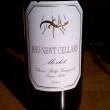Why I Hate Synthetic Corks (aka Bad Choices)
So I sat down last night to review a few different wines from Standing Stone Vineyards in the Finger Lakes region of New York. It’s a well-known producer and I’ve enjoyed both their dry vidal and vidal ice wine in the past.
Then I opened my only bottle of their 2003 Pinot Noir ($26).
As I slipped the capsule off, I was surprised to see a synthetic cork. In my experience, few wineries use them on a wine over $15 dollars — particularly not one that should have some cellar worthiness. So I extract the cork and pour…
Something is definitely wrong here. Instead of the Pinot Noir ruby beauty I expected, I was greeted with rusty, unappealing brick red. Definitely some browning…and in a wine this young, that is not a good thing. The nose was completely devoid of any fruit…just stale, musty aromas with a little wild mushroom. It was truly undrinkable.
I’m not a huge fan of Finger Lakes reds, but the ones that I’ve liked best have been pinot noir. I had high hopes for this one. Why would you use a synthetic cork on a wine like this? Why?


















What makes you blame this on the cork, rather than the fruit or the winemaking?
I don’t think that I can or should blame premature browning and oxidation on the grapes or winemaker, do you?
And synthetics are notorious for leading to oxidation…at least from what I’ve read.
There are plenty of quality Pinot Noirs closed with synth-corks in the Willamette Valley, and I’ve never had a problem with them.
Even given good fruit, there are numerous of ways to ruin a wine during wine making, bottling, shipping and storage. You can probably come up with as many as I can.
I have no doubt you’ve tasted oxidized wine from a bottle that had been open a day or two too long. Was it like that, or was it, perhaps, cooked from poor handling, or tainted with some sort of bacteria?
Even if synth-corks are prone to oxidation, is it more prevalent than cork-taint from the tree-bark kind?
All too often, synth-cork and other newer wine-related technologies get a bad rap, simply because they’re new and different, and wine culture over-values tradition.
Unless you bottle wine from the same barrel into two different sets of bottles - one with synth-cork and one with natural, then age them in the same controlled conditions and at points taste-test multiple bottles to determine the differences, I don’t think you can accurately trace any give flaw to the type of closure. I’d love to see the results of such a study; if you’ve run across one, a link would be awesome.
Hey…I agree with you that new closures get a bad rap. And as someone who reviews (or tries to review) wines every day, I deal with plenty of cork taint. In fact, I had two bad bottles this week.
I’m also a big proponent of screwcaps depending on the wine at hand. I don’t have much (okay any) experience with well-aged screwcapped wines. That said, I wish Long Island and Finger Lakes producers, particularly for white crisp whites (and rose), would make the switch.
They fear being lumped into the cheap jug wines I think. There are also probably some startup costs for new bottles/equipment.
This wine was definitely oxidized…and badly. I don’t think there was any bacteria taint or bad handling. There weren’t those cooked flavors you get sometimes. And as my wife can attest, I’m insanely careful about wine storage to the point of obsession.
If you see and taste a lot of quality Willamette wines that are bottled under synthetic, that’s interesting…interesting indeed. And yeah, I know they are a lot cheaper. I just think there is too much evidence that synthetics don’t provide long term seals.
But, I don’t have the numbers of leaking synthetic vs. TCA taint…that would be an interesting comparison. Anyone have these numbers?
From what I know of the research on synthetic corks, the polymers that are used to create the air pockets in them begin to break down after 3-4 years. Much of this is due to the combination of alcohol and acid in the wine acting on the closure. This is now common knowledge in the industry. There are few problems with them before this time however, so they are really best used for whites that are meant to be enjoyed young.
The data on screwcaps is now almost 40 years old and has always been quite clear - they are far superior to synthetic cork as a closure and have a 30-40 year life span with good results. To me, the synthetic cork is kind of a “missing link” in the evolution of the industry towards screw caps. I don’t think it will be around long for the above mentioned reasons unles they improve the materials and extend the life of the product.
As for some good Finger Lakes Reds, try Ravines 2005 Pinot Noir and the upcoming 2005 meritage (the 2004 aint bad either). I’ve been blown away by the quality considering that some FL reds aren’t so great. The French-trained oenologist at Ravines knows his reds, which are a pain to grow in the Finger Lakes. I agree that Pinot often shows the best potential in this region.
I just don’t get synthetic corks. Natural corks are time-proven but prone to ocassional problems. If good, they age wonderfully. Screw caps might not seem as poetic, but they certainly play the right role in sealing the wine in the bottle for as long as needed. Why would anyone use a plastic cork made of compounds that will degrade over time? It just doesn’t seem sensible-if a winery is willing to go synthetic, it should just go screw cap instead. How much of a drop in image is a screw cap over a plastic seal? The association with jug wines just doesn’t seem strong enough to me, especially with the other obvious differences in presentation.
Here, here on the Ravines reds. They’ve edged out my favorite Silver Thread Blackbird for best FL red. I just did a little write up of their House White today which was closed with a synthetic cork. I highly recommend their wines.
Recently had a South African Sauvignon Blanc that someone gave us because they liked the cool glass cork it used (glass bung with a plastic gasket) The wine was good, and the device was cool, but I didn’t see the gasket standing up to the test of time either.
Damiani Wine Cellars (www.damianiwinecellars.com)on the East side of Seneca Lake is doing an impressive job with Pinot Noir as well as the Shalestone Vineyards (www.shalestonevineyards.com)
Another positive nod to Ravines Pinot. I stumbled across the winery in summer 2005, and was highly impressed with the vintage (?2004)they were pouring at the tasting bar; then again this past summer (vintage 2005). If he keeps this up, I think he will be giving the Santa Barbara & Oregon vintners a run for the New World Pinot glory within a few years.
And, with the now-acknowledged quality of Rieslings (e.g. Hermann Wiemer), I think Finger Lakes may make the list of legitimate New World wine regions, within the next decade.